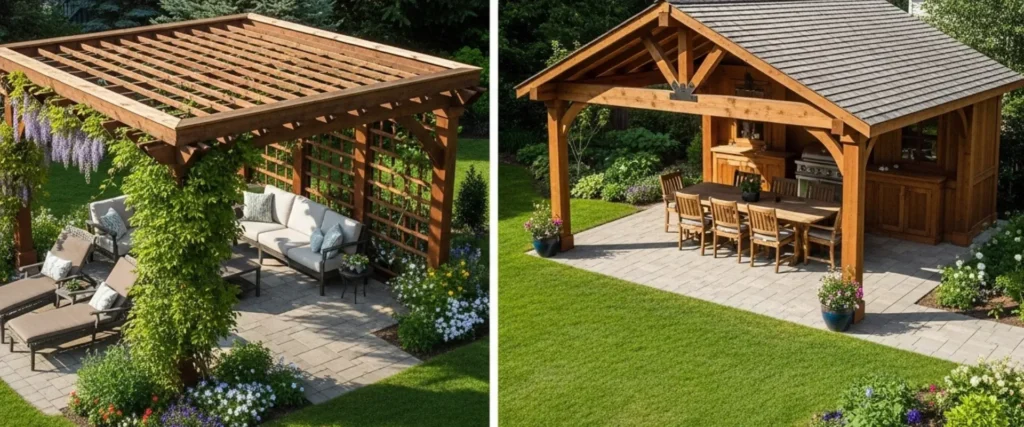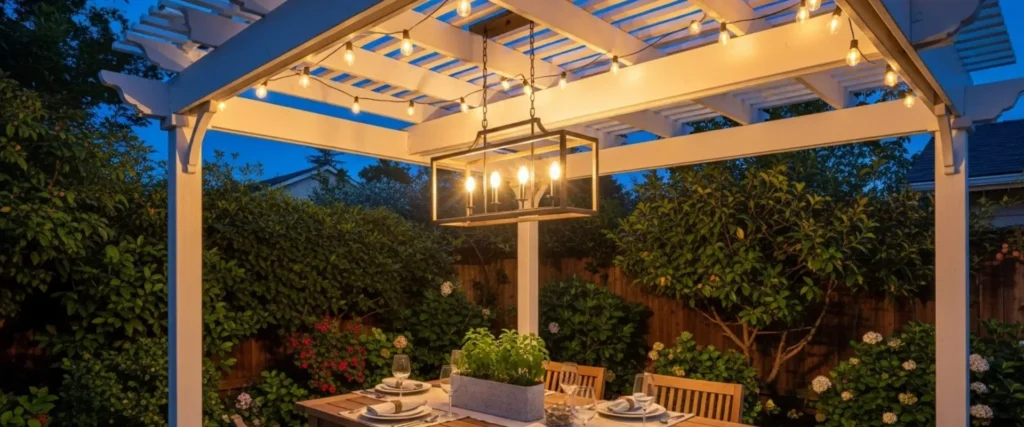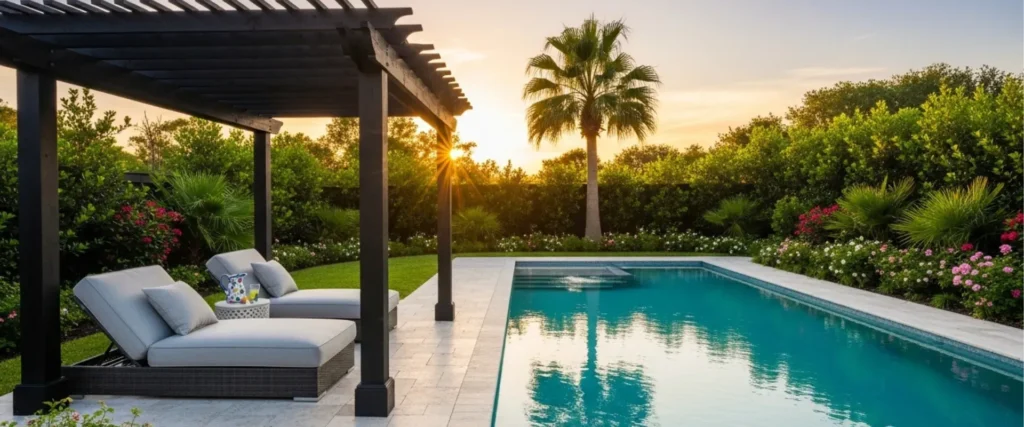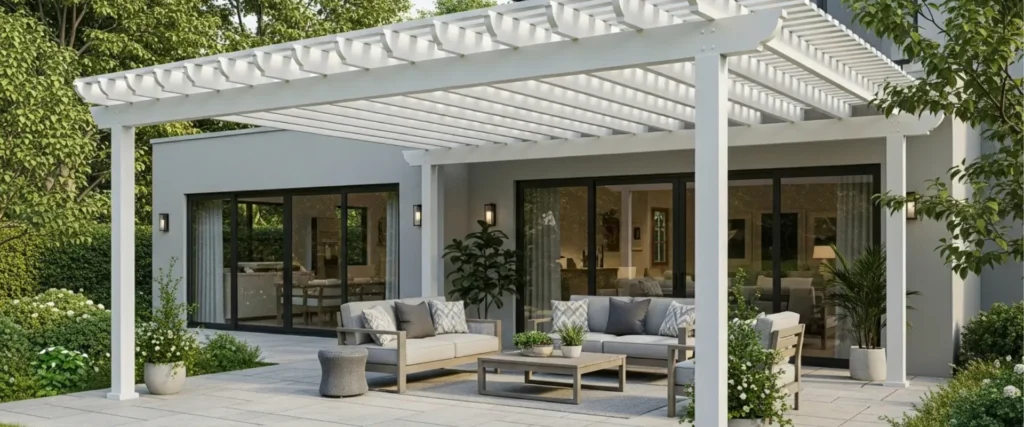Choosing the right backyard structure can transform your outdoor space into a stunning retreat. When considering pergola vs. pavilion options, many homeowners find themselves weighing the benefits of each structure. Both add beauty and functionality to your yard, but they serve different purposes and offer distinct advantages.
At Wood Kingdom West, we’ve helped Long Island families create their dream backyards for over 35 years. Whether you’re looking for a cozy pergola or an expansive pavilion, understanding the difference between pergola and pavilion structures will help you make the best choice for your outdoor living needs.
What is a Pergola?
A pergola is an outdoor structure featuring vertical posts that support crossbeams and an open lattice roof. This classic garden feature creates partial shade while maintaining an airy, open feel. Pergolas typically don’t have solid roofs, instead relying on wooden slats or beams that allow sunlight to filter through.
Most pergolas measure between 10 to 14 feet in width and can extend to various lengths depending on your space. The open-roof design makes them perfect for growing climbing plants like roses, grapevines, or wisteria, which add natural beauty and additional shade over time.
Key Features of Pergolas:
- Open lattice or slatted roof design
- Vertical support posts (usually 4-6 posts)
- Partial shade coverage
- Ideal for plant growth and climbing vines
- More budget-friendly option
- Quick installation process
What is a Pavilion?
A pavilion is a larger, more substantial outdoor structure with a complete solid roof that provides full weather protection. Unlike pergolas, pavilions offer complete overhead coverage, making them suitable for year-round outdoor activities regardless of weather conditions.
Pavilions typically feature more robust construction with heavier timber framing and can accommodate larger gatherings. They often include options for electrical wiring, ceiling fans, lighting, and even outdoor kitchens.
Key Features of Pavilions:
- Solid roof with complete weather protection
- Larger size options (typically 12×12 feet and up)
- More substantial construction materials
- Can include electrical features and amenities
- Year-round usability
- Higher investment but greater functionality


Pergola vs Pavilion: The Main Differences
Understanding these key differences will help you choose the perfect backyard structures guide for your needs.
1. Roof Coverage and Weather Protection
The most significant difference between pergola and pavilion structures lies in their roof design. Pergolas feature open roofs that provide partial shade and allow rain to pass through. This makes them perfect for sunny days but less practical during storms or heavy rain.
Pavilions offer complete roof coverage with materials like asphalt shingles, metal roofing, or cedar shakes. This solid roof protection means you can enjoy your outdoor space during light rain, snow, or intense sun exposure.
2. Size and Scale
Pergolas generally work well in smaller spaces and can be built to fit compact yards. They create intimate settings perfect for dining areas, garden walkways, or small seating areas.
Pavilions require more space due to their larger footprint and greater height requirements. They’re designed to accommodate bigger gatherings, outdoor kitchens, hot tubs, or multiple seating areas.
3. Construction and Materials
Pergola construction typically uses lighter materials and simpler joinery techniques. Most pergolas can be installed in 1-2 days with basic tools and moderate DIY skills.
Pavilion construction requires more substantial materials, deeper foundations, and professional installation. The heavier timber frame construction and complete roofing system make pavilions a more complex building project.
4. Maintenance Requirements
Pergolas require regular maintenance, including staining or sealing every 2-3 years, checking for loose connections, and managing plant growth if you’ve added climbing vines.
Pavilions need roof maintenance, gutter cleaning, and periodic inspections of the more complex structural elements. However, their solid construction often means longer intervals between major maintenance tasks.


Choosing the Right Structure for Your Space
Your decision between pergola vs. pavilion should consider several factors about your outdoor living goals and property characteristics.
1. Consider Your Climate
In areas with frequent rain or harsh winters, pavilions provide better year-round functionality. Long Island’s varied weather patterns make pavilions particularly valuable for homeowners who want consistent outdoor entertainment options.
Pergolas work best in drier climates or for homeowners who primarily use outdoor spaces during pleasant weather conditions.
2. Available Space and Yard Layout
Measure your available space carefully. Pergolas work well in smaller yards, against house walls, or as garden accents. They can even span between existing structures.
Pavilions need adequate clearance on all sides and enough space to feel proportionate to your property. A too-large pavilion can overwhelm a small yard, while a too-small pavilion might look lost on a large property.
3. Intended Use and Lifestyle
Think about how you’ll use your outdoor structure. If you want a cozy spot for morning coffee or an attractive support for climbing plants, pergola ideas might suit you perfectly.
For regular entertainment, outdoor dining, or all-weather outdoor activities, pavilions offer superior functionality. They can house outdoor kitchens, provide space for hot tubs, or create true outdoor rooms.
4. Budget and Timeline
Pergolas offer quicker installation and lower upfront costs, making them attractive for homeowners wanting immediate outdoor improvements.
Pavilions require larger investments but provide more substantial long-term value and functionality. Consider your current budget alongside your long-term outdoor living goals.
Popular Pergola Ideas for Your Backyard
Whether you’re following the top pergola trend or seeking timeless elegance, these ideas can inspire your design:


1. Garden Pergola Walkways
Create stunning garden transitions with pergola walkways that guide visitors through your landscape while supporting beautiful climbing plants.


2. Dining Area Pergolas
Position pergolas over outdoor dining spaces to provide comfortable partial shade during meals while maintaining an open, airy atmosphere.


3. Pool Area Pergolas
Install pergolas near swimming pools to create shaded seating areas without blocking too much sunlight from reaching the water.


4. Attached Pergolas
Mount pergolas directly to your home’s exterior wall to create seamless indoor-outdoor transitions and extend your living space.
Custom Solutions from Wood Kingdom West
At Wood Kingdom West, we specialize in creating custom outdoor structures that perfectly match your vision and lifestyle needs. Our experienced team can help you design either pergolas or pavilions that complement your existing landscape and home architecture.
Whether you’re looking for a quick pergola installation or designing custom backyard pavilion ideas with lighting and outdoor kitchens, our expert team ensures every detail is crafted for beauty and durability. Our structures are built using premium materials and time-tested construction techniques that withstand Long Island’s changing seasons.
Transform Your Backyard Today
Whether you choose a charming pergola or a substantial pavilion, either structure will enhance your outdoor living experience and create lasting memories with family and friends. The pergola vs. pavilion decision ultimately depends on your specific needs, budget, and long-term outdoor living goals.
Ready to start your backyard transformation? Contact Wood Kingdom West today to discuss your custom pergola or pavilion project. Our expert team will help you design and install the perfect outdoor structure for your Long Island home.
Frequently Asked Questions
Can I convert a pergola into a pavilion later?
Converting a pergola to a pavilion typically requires significant structural modifications, including stronger foundations, additional support posts, and complete roof reconstruction. It’s usually more cost-effective to build a pavilion from the beginning if you want full roof coverage.
Which structure adds more value to my home?
Both structures can increase property value, but pavilions typically provide greater value increases due to their substantial construction and year-round functionality. However, the actual value depends on your local market and overall property characteristics.
How long do pergolas and pavilions last?
Well-built pergolas typically last 15-25 years with proper maintenance. Quality pavilions can last 30-50 years or more due to their more robust construction and complete weather protection.
Do I need permits for pergola or pavilion installation?
Permit requirements vary by location and structure size. Generally, pergolas under 200 square feet may not require permits, while pavilions usually do. Check with your local building department before beginning any project.
Can I install either structure myself?
Basic pergola kits can be DIY projects for experienced homeowners with proper tools and skills. Pavilions typically require professional installation due to their complex construction, electrical requirements, and structural engineering needs.

